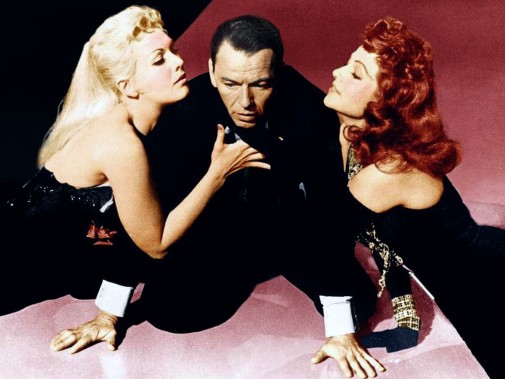
Born Margarita Carmen Cansino, Rita Hayworth was one of Old Hollywood's brightest and most glamourous stars. As it often happens with such legends of the silver screen, her life was an unhappy one, full of tales of abuse and five failed marriages, crippling insecurity, alcoholism and Alzheimers. Perhaps more hauntingly, her biographers agree that Hayworth despised her existence as a movie star and as a pin-up icon, longing to escape the movie business in her heyday. In Hayworth's later years, she would even come to express disdain towards some of her more famous movies like the iconic Gilda. Still, those same pictures, as well as other classics, made her an immortal legend.
To explore the filmography of Rita Hayworth is to confront the cruel incongruences of her biography, how the movies sculpted her into something bigger than life and made her suffer for it too…

Many of the stars' most important works are currently available to watch online, either by streaming or rental. Just the Criterion Channel has a wonderful collection of 13 Hayworth flicks, which span from the 1930s to the late 50s. However, it's difficult to find the actress' earlier screen appearances, when she was either credited as Rita Cansino or went unnamed altogether. Because of the perceived ethnic quality of her looks, she was limited by studio authority to bit parts or small appearances that made use of her skills as a trained dancer. It was the corrosive influence of her first husband as well as the best cosmetic transfiguration Columbia Pictures could buy that gave her a style more easily marketable.
Gone was her father's surname as well as Rita's raven locks, now dyed dark red. Her hairline was also altered, lifted thanks to experimental electrolysis to give her a more Caucasian look. The miasma of racism and misogyny that got Rita Hayworth to stardom is repugnant, but we shouldn't stop appreciating her talents because of this. For instance, one of her first big roles after the makeover was in Howard Hawk's 1939 flick Only Angels Have Wings, where she's wonderful in a supporting role. It was a popular hit at the time and helped make Rita one of Columbia's brightest new stars. One year later, she was already headlining star vehicles built around her magnetic presence.
Rita was especially brilliant in musicals, though her singing was always dubbed. Her pairings with Fred Astaire in 1941's You'll Never Get Rich and 1942's You Were Never Lovelier are beguiling examples of musical romcoms at their most charming. Many years after, Astaire would name Hayworth as his best dance partner onscreen. You need only see a few minutes of their numbers to understand why, for she is magnificent. At the same time, Hayworth was also cast in more dramatic projects, often in the roles of seductive temptresses. An example of this is the bleak 1940's proto-noir Angels Over Broadway, her breathy line deliveries seem like a prelude to the character type Marilyn Monroe would come to perfect a decade later.
The 40s were Hayworth's greatest decade, though the shy actress balked at the attention she received. One of the greatest surprises one finds when researching this starlet's life is how radically different she was from her vixen public persona. That preternatural sexual confidence Hayworth exuded onscreen was a masterful bit of acting which always looked effortless. The dichotomy between the woman and the celebrity wouldn't go unnoticed by the filmmakers that worked with her. On one hand, there are the movies that make the impossible magnetism of her screen presence in comedy, like Cover Girl or Down to Earth, where Hayworth literally plays a Greek goddess. When she smiled in those cinematic trifles, it was as if the sun broke through deep grey clouds, warming up our very soul.
On the other, when giving life to apparent Femme Fatales like Gilda or Chris Emery of Affair in Trinidad, Hayworth was capable of finding depths of unease hiding beneath the surface-level sensuality. Her temptresses are always more complex than they seem, either knowingly weaponizing their desirability or internally resenting it. Orson Welles' The Lady of Shanghai is particularly ruthless in its exploration of her star persona, dissecting it with cruel abandon and giving the actress one of the juiciest roles of her career. Hayworth's talents would become especially useful in the 50s when noirs gave way to moralistic tales of punished libertines like Miss Sadie Thompson or Salomé. She's often the only tolerable element of those movies.
As her personal life became increasingly complicated and the years started to weight on Rita, Columbia started to let go of her. Kim Novak was a temporary substitute and the two even starred together in a repulsive adaptation of Pal Joey. The story of that 1957 flick may center on Frank Sinatra's lothario but it's the baton passing of one female sex symbol to another that makes it an important historical artifact. Later on, the roles would start to dwindle and so did Hayworth's popularity. Still, even in small supporting roles in movies like 1965's The Money Trap, her magnetism was undeniable as was the melancholy that always haunted her screen appearances.

Though tragic, Rita Hayworth's tenure as a Hollywood star is worth celebrating. I urge you to seek out her pictures and let yourself fall in love with the Love Goddess herself, one of the greatest stars that ever was.